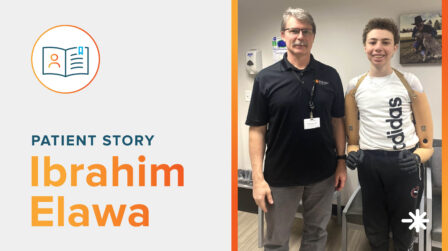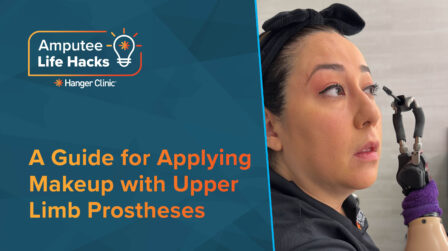Upper Limb Congenital Limb Difference
When one or both arms of a child do not form fully in the womb.
Understanding Upper Limb Congenital Limb Difference
Upper limb congenital limb difference is a condition where one or both arms of a child do not form fully in the womb. It can involve any structure of the arm, from the fingers up to the shoulder. It has no known cause and is not related to a woman’s stress level, eating habits, work type, or other factors during her pregnancy.
Congenital upper limb difference is classified into two major categories, amniotic band syndrome and failure of formation. Either type can be diagnosed prior to birth during an ultrasound but is usually diagnosed at birth.
Treatment
Children and adults will wear multiple types of prosthetic arms throughout their life, and the most appropriate device will change with the child’s age, activity needs, and preferences. Upper limb differences typically follow one of the following treatment options.
- No prosthesis – There are times that not wearing a prosthesis at all is the best option for your child.
- Passive prosthesis – A passive prosthesis is often used as a stepping stone to a prosthesis with grasping movement. Passive devices are lightweight and can stabilize activities like tummy time, sitting, and cruising. They can also allow your child to hold toys and other objects between their hand and the prosthesis. This type of prosthesis can be fit when your child is able to sit on their own.
- Body-powered prosthesis – This type of prosthesis allows your child to grasp an object actively. A body-powered device uses a harness that crosses your child’s back to open or close the prosthetic hand or hook. Your child will move their shoulders to pull on the harness, which will move the hook or hand to grasp an object. This type of prosthesis tends to be easy to learn to use, lightweight, and durable. A body-powered prosthesis can be fit when your child is able to understand cause and effect generally around 2-3 years of age.
- Myoelectric prosthesis – A myoelectric prosthesis uses sensors built into the prosthesis to read your child’s muscle activity through the skin. When your child flexes one muscle, the hand or elbow of the prosthesis will move in one direction. Your child can flex a different muscle to move the prosthesis in the opposite direction. This type of prosthesis might be best for a child that needs more grip strength than a body-powered prosthesis can provide. These devices have batteries and motors inside of them to create movement, which causes them to be heavier than other options. They are also not typically waterproof. A myoelectric prosthesis is often recommended when the child has outperformed the body-powered prosthesis or when a body-powered system is not a viable option. This prosthetic option is generally considered around 5 years of age or older.
- Hybrid prosthesis – This type of prosthesis is typically used for a patient with an above-the-elbow or higher limb difference, but uses the combined efforts of a body-powered and a myoelectric prosthesis. These tend to be lighter weight than a full myoelectric prosthesis and decrease how much strength and movement is needed compared to a fully body-powered prosthesis.
- Activity-specific prosthesis – This type of prosthesis is designed for your child to use for a recreational activity or sport. Instead of a hook or hand, your child may have an attachment that allows them to play an instrument, use sports equipment, or engage in other activities. Your child may only wear this type of prosthesis for specific activities.
Latest Updates
Subscribe to stay up-to-date on our latest posts.


